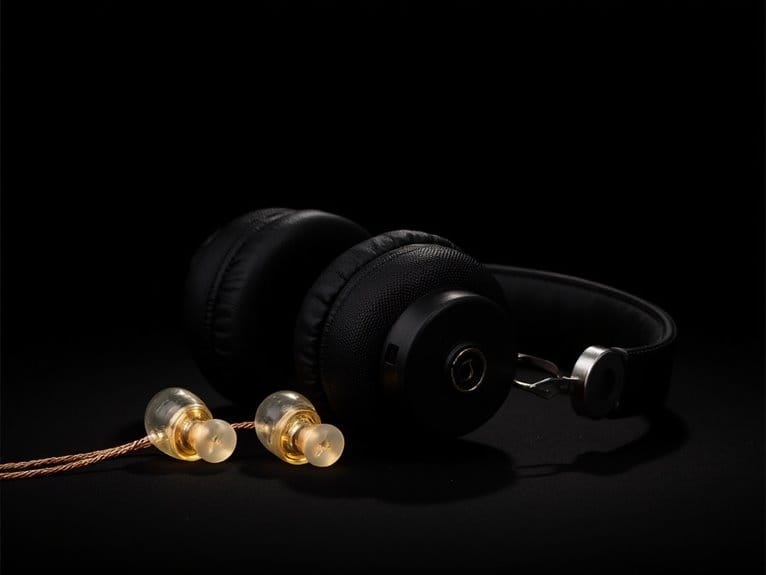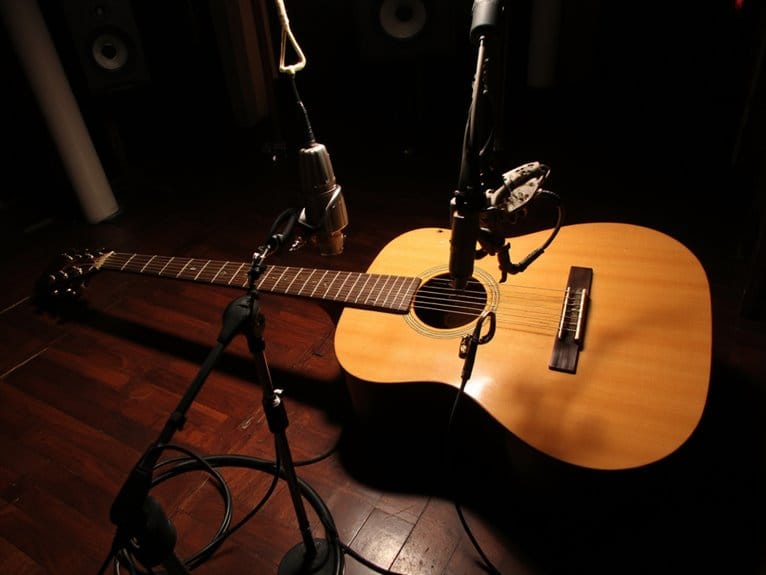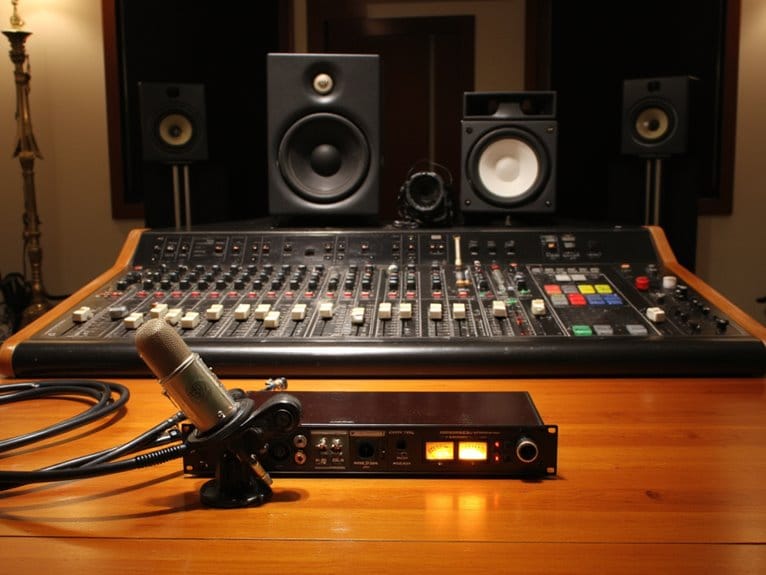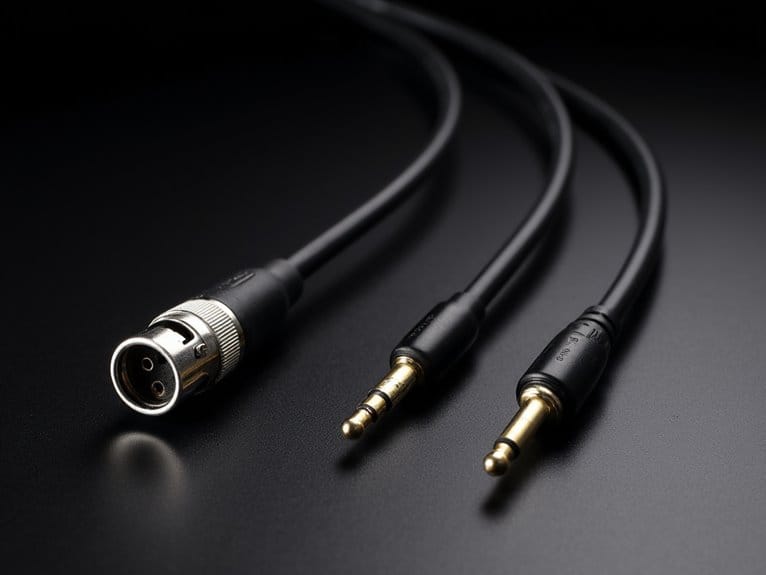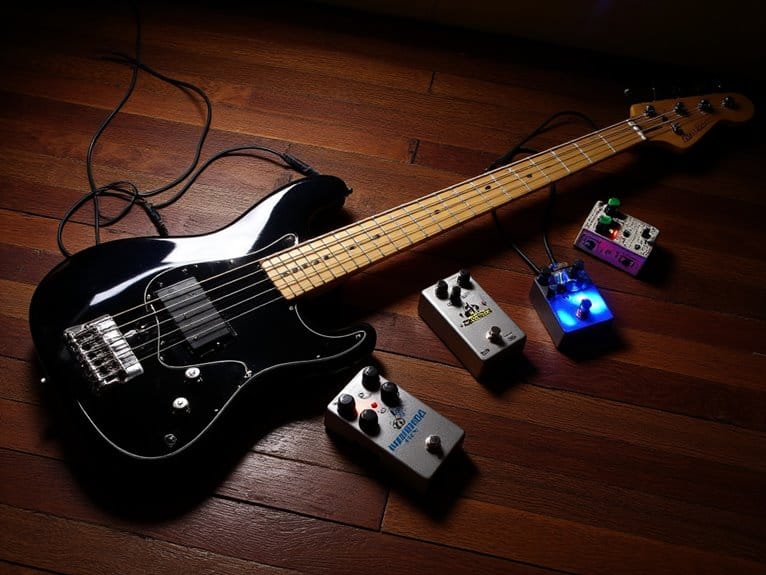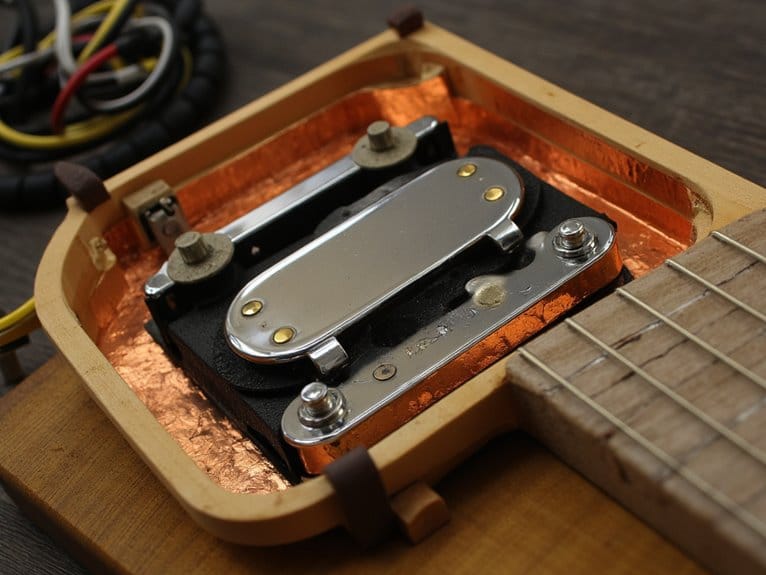In-Ear Monitors Vs Over-Ear Headphones for Performers
For performers, you’ll find that in-ear monitors offer superior noise isolation with up to 37 dB ambient reduction and intimate sound placement, while over-ear headphones provide wider soundstage and powerful bass through larger drivers. IEMs excel in portability and stage mobility, fitting in your pocket, whereas over-ears require bulky cases and dedicated amplification. Custom-molded IEMs typically retain better resale value, though both options start around $50-$150 for entry-level models, and exploring the nuanced differences reveals critical performance considerations.
We are supported by our audience. When you purchase through links on our site, we may earn an affiliate commission, at no extra cost for you. Learn more.
Notable Insights
- IEMs provide superior noise isolation with up to 37 dB ambient noise reduction, essential for clear monitoring during loud live performances.
- Over-ear headphones offer wider soundstage and better bass response through larger drivers, but suffer from sound leakage issues.
- IEMs are highly portable and smartphone-compatible, while over-ear headphones require bulky cases and dedicated amplification equipment for optimal performance.
- Comfort varies significantly: IEMs need proper ear tip fitting to prevent soreness, while over-ears may cause heat buildup under stage lights.
- Professional IEMs feature detachable cables for easy replacement and typically retain better long-term value compared to over-ear headphone models.
Sound Quality and Audio Performance Differences
Most audiophiles will tell you that the fundamental difference between in-ear monitors and over-ear headphones lies in how they deliver sound to your ears, and I’ve found this creates distinctly different listening experiences that go far beyond simple preference.
The soundstage differences become immediately apparent when you switch between them, with over-ears creating that wider, “out-of-head” spatial effect that mimics concert halls, while IEMs deliver intimate, direct sound placement. IEMs often achieve this precision through multiple driver types including balanced armatures, dynamic drivers, and electrostatic components working in harmony.
Bass response varies greatly too, as over-ears move more air through larger drivers for physical impact, whereas IEMs compensate with tight, well-defined low-end that feels immediate due to direct ear canal coupling, making each format excel in different musical contexts. The sound isolation capabilities of in-ear monitors create a natural seal within the ear canal that helps block outside noise during performances. Quality IEMs can provide up to 37 dB of ambient noise reduction, which proves essential for performers working in loud club environments.
Professional-grade IEMs also offer detachable cables that allow for easy replacements and upgrades, extending their lifespan and reliability during performances.
Comfort and Fit Considerations for Stage Use
When you’re performing on stage for hours at a time, comfort becomes just as critical as sound quality. I’ve learned through countless gigs that the physical demands of live performance can make or break your monitoring choice.
IEMs create a tight seal within your ear canal, offering superior isolation but requiring careful fit optimization to prevent soreness during extended use. Quality ear tips made from silicone or memory foam are essential for achieving both comfort and effective noise isolation during performances.
Over-ear headphones distribute pressure more evenly around your ears, though they can cause heat buildup and sweating under stage lights.
Your comfort strategies should include selecting proper ear tips for IEMs or adjustable headbands for over-ears, taking regular breaks to prevent fatigue, and considering custom-molded options if you’re serious about long-term performance comfort and stability. Professional-grade IEMs typically provide up to 38 dB noise isolation, which protects your hearing while allowing you to monitor your performance clearly in loud live environments.
Portability and Equipment Requirements
Beyond the physical demands of extended wear, the practical realities of touring and performing quickly reveal how equipment size, power needs, and setup complexity can dramatically impact your monitoring workflow.
| Aspect | IEMs | Over-Ear Headphones |
|---|---|---|
| Transport Options | Pocket-sized cases, effortless mobility | Bulky carrying cases required |
| Power Requirements | Smartphone-compatible, minimal amplification | Dedicated headphone amplifiers needed |
| Setup Complexity | Cable management, custom fit considerations | Plug-and-play simplicity |
IEMs excel in portability, fitting into your pocket while over-ear models demand dedicated storage space. However, you’ll find IEMs require more attention to cable management and proper ear tip selection, whereas headphones offer straightforward connectivity but need robust amplification for peak performance, making your equipment chain considerably more complex during live situations. The convenience of detachable MMCX cables in many professional IEM models allows for easy replacement and maintenance, reducing performance interruptions when cables become damaged during intensive touring schedules.
Cost Analysis and Long-Term Investment Value
While most musicians focus solely on sound quality when choosing monitoring equipment, I’ve learned that understanding the complete financial picture—including upfront costs, ongoing maintenance, and long-term value retention—often determines whether you’ll stick with your investment or find yourself shopping for replacements within a few years.
Initial pricing reveals surprising similarities, with both over-ear headphones and IEMs starting around $50-$150 for entry-level options. However, the real story emerges in maintenance costs and durability patterns.
You’ll replace ear pads every 1-3 years on headphones, while IEMs demand regular ear tip replacements and more frequent cable swaps.
High-end IEMs typically retain better resale value, creating long term savings despite higher upfront investments, especially for custom-molded units that can exceed premium headphone prices considerably.
Frequently Asked Questions
Do IEMS or Headphones Cause More Ear Damage With Prolonged Use?
IEMs can cause more ear damage if you’re not careful with volume since they deliver sound directly into your ear canal. However, their superior sound isolation provides better ear protection by reducing external noise interference.
Which Option Works Better for Drummers Versus Vocalists or Guitarists?
Your drummer needs favor IEMs for isolation and movement during performance settings. Vocalist preference varies between IEMs for clarity and over-ears for natural soundstage. Guitarist choices depend on whether you prioritize precision monitoring or fuller bass response.
How Do Wireless Versions of Each Affect Battery Life During Long Shows?
Wireless technology affects your battery management differently – you’ll get 6-8 hours from IEMs versus 12-30+ hours from over-ear headphones. You’ll need backup batteries for IEMs during extended performances, while headphones typically last entire shows.
On a final note
You’ll need to weigh your specific performance needs against practical constraints when choosing between in-ear monitors and over-ear headphones. If you’re prioritizing stage mobility, noise isolation, and professional monitoring capabilities, IEMs represent the superior choice despite higher upfront costs. However, if you’re working within budget limitations or performing in controlled acoustic environments, quality over-ear headphones can deliver excellent results while offering greater comfort during extended sessions.

